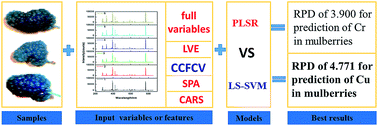A novel method to extract important features from laser induced breakdown spectroscopy data: application to determine heavy metals in mulberries
Abstract
Laser-induced breakdown spectroscopy (LIBS) data generally contain abundant “fingerprint” variables. Previous studies were mainly based on analyzing characteristic emission lines or full LIBS variables, and did not fully exploit the useful information in LIBS data. To extract more useful features from LIBS data, we proposed a novel method called cross computation between full and characteristic variables (CCFCV). Compared with full variables, characteristic variables at emission lines, threshold variables selected by the low-intensity variable elimination (LVE) method, and important variables selected by successive projections algorithm (SPA) and competitive adaptive reweighted sampling (CARS), the proposed CCFCV method provided better prediction for both Cr (residual predictive deviation (RPD) of 3.900) and Cu (RPD of 4.771) contamination in mulberries. The results of this work show that CCFCV is an effective way to extract LIBS spectral features and could improve the model's prediction accuracy and robustness.



 Please wait while we load your content...
Please wait while we load your content...